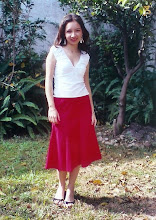Eisenach.
Visited Warburg Castle, which is what makes Eisenach a UNESCO World Heritage site. It was really hot today so hiking the 2 kms up the hill was rather slow-going. Anyway, the castle is famous because here is where Martin Luther hid for a while when he got in trouble with the Catholic church for being a bit of a "hell raiser" (ha ha ha! I love my bad puns!) and translated the Bible into German. The Bible had been translated into German before but the innovation that Luther did on this one was that he translated it directly from the Latin and Greek.
The Castle itself was not too exciting, a bit small, but I've seen better (Malbork Castle in Poland just one example), and the guided tour was too long. Or maybe I was in an impatient mood due to the heat, I don't know.
After getting back down into the little 1600's architecture-style town of Eisenach I visited the Bach's House museum (not in his original house, which no longer exists, but in the same general village quarter), but it was a bit disappointing because there were no real displays (the sheet music/scores for instance were always facsimiles or copies only, or pictures of facsimiles, etc.), maybe an old violin here, and a lot of lithographs of Eisenach from the 1700's. The exhibit also did not focus at all on Bach's music, just his life, which other than the fact that he fathered 20 children (most died in infancy), was not particularly exciting or as interesting as his music. I would've preferred a more musicological focus including for instance some mention of why his works were so innovative at the time (one reason for example was his frequent unabashed use of the augmented 4th, also known as the tritone, or also known as the dreaded "devil's interval"---kinda neat given that Bach made a career of being church organist, church composer, and choirmaster!, or his unsurpassed polyphonic contrapunctual technique, or his brilliant "teach by example" treatise The Art of the Fugue) and why his works are so important even to this day (influences on Mozart, Mendelssohn, Shostakovich, and Schönberg to name just a few).
The museum's claim to fame lies in a little 30 hour didactic concert/demo where some of Bach's works are played on original instruments live. It was a pleasant little diversion that was good enough for tourists, but the pieces were not particularly choice pieces (mostly two or three of his easier Little Preludes, some Anna Magdalena Bach, and the simple Prelude No. 1 from the Well Tempered Klavier. Funny too, all works were in the baby-can-play key of C major--except the minuet in G of the Anna Magdalena, the most trite, overplayed, and by virtue of this rather dreaded--for me at least--of all of Bach's ditties), and the interpretation, as well, fair but not concert quality (my fault on expecting more from that one. Eisenach is a teeny weeny unknown town smack in the middle of nowhere, pretty much). What was worse, of course, was the fact that although the original instruments were kind of neat, the choice of pieces did not effectively showcase them, let alone scratch the surface of the depth and sublime beauty of Bach, which was too bad.
No, I'm not done. If this is the museum in the spot of Bach's birthplace, you'd at least expect a decent gift shop. This one was equipped with perhaps 15 CDs for sale. Anything exciting? No, a small repertoire of rather obscure works, only the Brandenburg Concertos and a secular Cantata here or there excited a mildly interested second look, but several of them turned out to be recorded by local (Eisenach) performers (i.e. not the most professional editions, that is), no Glenn Gould or any of the major German orchestras, so, what's the point?
The saddest part of all: no sheet music for sale. Looks like I'll have to wait until I get to Berlin for that one....

1 comment:
Oh, sweet, venerated master! That's ok, he didn't like Eisenach himself.
Post a Comment